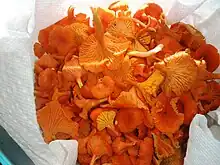Cantharellus cinnabarinus
Cantharellus cinnabarinus, the red chanterelle, is a fungus native to eastern North America.[1] It is a member of the genus Cantharellus along with other chanterelles. It is named after its red color, which is imparted by the carotenoid canthaxanthin.[2] It is edible and good, fruiting in association with hardwood trees in the summer and fall.[3]
| Cantharellus cinnabarinus | |
|---|---|
 | |
| Scientific classification | |
| Domain: | Eukaryota |
| Kingdom: | Fungi |
| Division: | Basidiomycota |
| Class: | Agaricomycetes |
| Order: | Cantharellales |
| Family: | Cantharellaceae |
| Genus: | Cantharellus |
| Species: | C. cinnabarinus |
| Binomial name | |
| Cantharellus cinnabarinus (Schwein.) Schwein. 1832 | |
| Synonyms | |
|
Agaricus cinnabarinus Schwein. 1822 | |
| Cantharellus cinnabarinus | |
|---|---|
| Ridges on hymenium | |
| Cap is infundibuliform | |
| Hymenium is decurrent | |
| Stipe is bare | |
| Spore print is white to pink | |
| Ecology is mycorrhizal | |
| Edibility is edible | |
Description
Cantharellus cinnabarinus is recognized by its distinctive flamingo-pink or bright orange and red colors (imparted by the carotenoid canthaxanthin) and the presence of false gills underneath the cap.[4]
Ecology
Widely distributed in Eastern Northern America; found mostly on the ground in broadleaf and mixed broadleaf/conifer forests; usually scattered or occurring in small groups; forms mycorrhizal associations with forest trees in the summer and fall; shows preference for acid soils.[5]
References
- Kuo, M. (June 2003). "Cantharellus cinnabarinus". MushroomExpert.Com. Retrieved 2011-03-23.
- Haxo, Francis (Dec 1950). "Carotenoids of the Mushroom Cantharellus cinnabarinus". Botanical Gazette. 112 (2): 228–32. doi:10.1086/335653. JSTOR 2472791. S2CID 84308852.
- Miller Jr., Orson K.; Miller, Hope H. (2006). North American Mushrooms: A Field Guide to Edible and Inedible Fungi. FalconGuides. Guilford, CN: Globe Pequot Press. p. 333. ISBN 978-0-7627-3109-1.
- "Cantharellus cinnabarinus (MushroomExpert.Com)". www.mushroomexpert.com. Retrieved 2021-04-04.
- "Chanterelle – Identification, Distribution, Edibility, Ecology, Sustainable Harvesting – Galloway Wild Foods". gallowaywildfoods.com. Retrieved 2021-04-04.